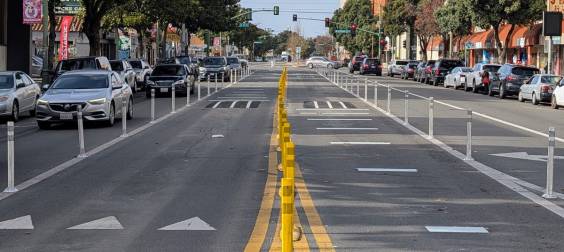A week ago today, the San Francisco Municipal Transportation Agency decided unanimously to move forward with concrete boarding islands on the L-Taraval. And maybe, just maybe, it was also a concrete turning point towards finally putting safety first.
As Streetsblog readers know all too well, every time SFMTA develops transit improvements as part of its Muni Forward program, the agency encounters enormous pushback. It comes from competing agencies, local politicians, but, more often than not, from a loud minority of angry stakeholders. And whether it's the Mission, Masonic, or Van Ness, it's this pushback that gets covered in the mainstream press.
The resulting political pressure causes delays, watered-down projects, and—more often than not—a failure to adhere to the voter approved "transit first" policies dating back to the 1970s. In other words, a minority of self-interested and ill-informed people are given more political sway than the voters.
Streetsblog attended three different meetings on the now-approved L-Taraval improvement plan--two were in City Hall and the third was the now-infamous shouting fest at Diane Feinstein Elementary school. Each time, and at last week's meeting at the SFMTA board, the same kind of victim-blaming, and excuses were heard.
The new, Hail-Mary tactic of opponents: delay the project. "Please allow entire project to be pilot project, then have six months to do joint design with SFMTA," said one speaker, before complaining about the loss of parking. Loss of parking, as with other projects, was the overriding theme. "See if you can prevent that one-in-a million accident without causing such massive loss of parking on Taraval," said Paula Katz of the organization, “Save our Stops," in a side interview at the meeting with Streetsblog.
And then there was the man who shouted at the February meeting that 22 people getting hit while alighting the trains “doesn’t seem like that many” and does not warrant making changes at all.
At first, San Francisco Supervisor Katy Tang seemed to cave to some of these noisier interests. But she correctly identified the group dynamics at play in the big public meeting and opted instead to work separately with small groups of constituents. This allowed SFMTA to parse legitimate concerns that could be addressed, rather than losing them in the rabble of the traditional big-meeting format for community outreach.
This gave the SFMTA board the ability to strategically direct SFMTA staff. For example, yes, perhaps it makes sense to maintain the stop in front of the Safeway on Taraval. People carrying groceries probably do need the stop closest to the store.

The result was, perhaps, a new kind of politics. "Our office believes that safety is non negotiable," said Ashley Summers, a staffer for Tang's office, who came to address the SFMTA board prior to the vote on Taraval. "Boarding islands are the only way to address the safety of Muni passengers."
That said, Jarlene Choy, a staffer for Supervisor Norman Yee, read a letter from her supervisor that missed its own point. "The priority has always been pedestrian safety," she read, before supporting the same delaying tactics of the safety opponents. "I urge a six-month pilot program so SFMTA can evaluate input into the pilot project."
SFMTA has to "evaluate" concrete boarding islands--which have proven their safety value on transit lines all over the city? Fortunately, the Board wasn't having it.
Now, that said, Walk San Francisco is not happy that five stops won't get concrete boarding islands right away, and they're absolutely justified in their concerns. "We're encouraged that the SFMTA Board unanimously approved the project as a whole, rather than bowing to anti-public transit and safety voices," said Nicole Ferrara, Executive Director of Walk SF. "The fight is far from over, however. In six months the Board will revisit the pilot treatment and decide whether or not to keep that option, based on a 90 percent driver yielding rate."
Ferrara was referring to the five "experimental" boarding islands that will get paint treatments in the initial build of the project, rather than concrete. SFMTA chose the stops, which are inbound only, because they have the fewest boardings and no history of incidents. However, it started to become clear that even this political compromise on safety is not going to last, as echoed in the statements of almost everyone on the SFMTA board. "I just can not see dropping people off into traffic," said director Lee Hsu, about the proposed six-month delay and the experimental boarding islands. "I don’t want to delay on the safety options," added Cheryl Brinkman, another director.
All of which was very promising.
“One of the things that stands in the way is often times a small number of deluded people are the ones who show up. And they complain and their complaints may be irrational and factually incorrect. But because they show up, they’re the ones who win the day,” said Jeff Tumlin, Principal and Director of Strategy at NelsonNygaard Consulting, in a previous Streetsblog post.
But this time at least, it seems that Tang and the SFMTA have started to figure out the political work-arounds to make sure safety and the needs of the many, aren't forever lost in the shouts of an irrational few. It's done through smaller, side meetings. It's done through more targeted outreach. And, in the future, it will be done by abandoning altogether the big-meeting format of community outreach.







